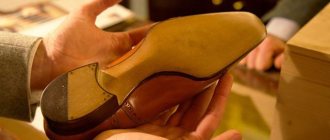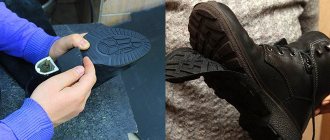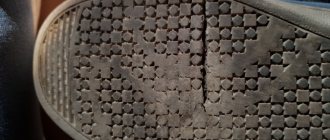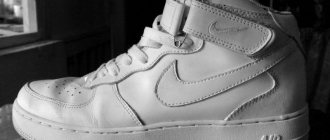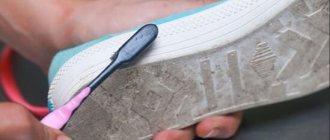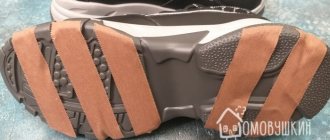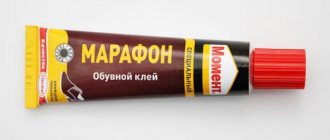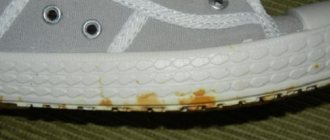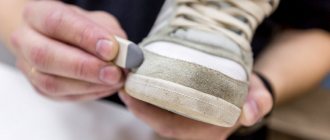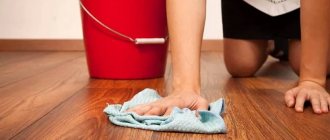Share on social media networks:
The sole of any shoe is subject to varied and constant stress, and even the most durable, ultra-modern products are unlikely to be able to provide insulation for the foot for a long time. When solving the problem of what to use to seal a cracked sole, you should at the same time get ready to purchase a new pair. During factory repairs, the sole repair itself is carried out by replacement. Quite often during this process, shoes lose their original shape and their appearance becomes very unpresentable. If there is no opportunity to buy a new pair, or there is nothing to wear to the shoe store, you will have to think about how to seal a broken sole. It is still possible to make high-quality repairs to the soles of sneakers at home with your own hands, but how long-term the result will be is difficult to answer. If you decide to take on such a task, then our article will help you.
What and how to seal the soles of autumn or winter shoes?
The familiar “Moment” glue (although professionals don’t really recommend it), epoxy sealant “Crazy Hands”, as well as a product with polyurethane “Desmokol” or nairite glue are suitable as available tools. Fortunately, each glue has its own instructions, which you need to follow while working.
Important! It is also necessary to take into account that these products are quite toxic. If they get on the mucous membranes, they must be quickly washed off under running water.
Algorithm for performing the work:
Based on the fact that winter or autumn shoes, as a rule, have soles of a honeycomb structure, first you will have to deal directly with the honeycombs:
- Remove the rubber that covers them to such an area in order to remove absolutely all accumulated dirt from the holes. Sometimes it happens that access to the honeycombs can be made from the side of the insole, which must be removed during cleaning in order to remove all dirt from the holes.
- Fill the honeycombs with small scraps of micropores, and then carefully fill them with silicone sealant and compact them thoroughly.
Important! Be sure to allow the sealant to dry and harden before sealing the cracked sole.
- After this, cut out a piece of rubber or micropore that fits directly into the hole.
Important! If it is voluminous, press the small holes with a mixture of micropores, sawdust and sealant.
- Based on the size of your shoes, cut out the sole from thin rubber, then stick it using a pre-prepared adhesive over the entire area of the shoe.
- Place shoes or boots directly under the press, which can be any heavy object.
- How long the glue needs to dry completely will be indicated in the instructions for it.
Important! How to seal a hole in the sole of a summer shoe? You should follow exactly the same algorithm, but there will be much less hassle:
- If the sandals are adhesive, it is better to purchase rubber soles from a workshop and glue them on yourself using rubber glue. This can be done when the shoe has a solid base.
- Sometimes soles are attached to light summer shoes solely along the contour.
Tread rehabilitation
The vulnerable part is the protectors, especially their heel part. For example, due to active use they may burst. If you need to repair these elements, you will need a piece of hard rubber (the sole of some unnecessary shoes may come in handy). You will also need coarse sandpaper, a sharp knife, and shoe glue. The algorithm of actions will be as follows:
- A rubber patch is cut out to match the shape of the old tread.
- The patch is given a wedge-shaped shape using a knife and sandpaper.
- To make the surfaces to be glued rough, they are treated with sandpaper. Then they are wiped with solvent and left to dry.
- The patch is covered with two layers of glue. The area where the new protector will be placed is processed in the same way. The first layer dries in 20 minutes, and the second in about 5 hours.
- After the adhesive composition has dried, the surfaces are heated over the stove until a characteristic odor appears. Then they are pressed tightly against each other and held until they cool down and are firmly fixed.
Can I wear sneakers with repaired treads right away? If there is an urgent need, then this is permitted. However, it is better to wait a day before using it - this will make the design as reliable as possible.
Sports shoes - how to repair?
If the training process in the gym has yielded results not only in the form of better physical shape, but also broken shoes, you still won’t have to give up your favorite pair of sneakers.
Of all the domestic adhesives, it is best to use epoxy, which is specifically designed to solve the problem of repairing sneakers with your own hands. Its cost is quite low, and its application will be simple:
- Thoroughly clean all the edges of the hole in your sole and then degrease it with a solvent.
- Once everything is dry, carefully apply properly diluted epoxy glue.
Important! Keep in mind that this mixture is very toxic. Therefore, be extremely careful when repairing the soles of sneakers with your own hands.
- If the hole is large enough, it would be a good idea to put a mesh in it, which is made of fiberglass, it is called serpyanka.
- While the glue dries, it is better to cover the area of the hole that appears on the outside with masking tape so that the sole remains completely flat.
Method 5
Repair of winter shoes using one-component, rubber-based polyurethane adhesive. You can take “Monument PVC” glue. It is also often used to repair PVC boats.
- Clean and dry thoroughly the surfaces to be glued.
- Bend the sole and use coarse sandpaper inside the crack to degrease it.
- Apply glue to both sides of the defective area. Wait 15 minutes and apply another layer of adhesive. Note: the entire time the glue is applied and dries, the crack must be open.
- After 5 minutes, straighten the sole and join the surface to be repaired.
- Next, to fix the sole, take a round stick, place it lengthwise and secure it with a rope. Place the shoes on the table, with the soles facing you, and heat them with a hairdryer for 30 minutes. The heating temperature should be 60 °C.
If you repair your shoes in the evening, you can go out in them in the morning.
Other types of glue:
- An excellent adhesive option is American Seamgrip glue. It is used to seal rubber boats. If you manage to purchase it, you won’t have to part with your favorite pair of sneakers. This is the only type of glue that can completely solve the problem of holes in a polyurethane or rubber sole.
- Imported epoxy adhesives like Done Deal are much better than domestic adhesives, but you can’t promise durability for sneakers when using it.
What to do if there is a hole in the heel of your shoe?
In order to remove the hole in the heel of the sole you will need tape, epoxy glue, hardener:
- wash the shoes, remove any debris that has gotten into the crack in the heel, dry the shoe;
- mix epoxy glue with hardener;
- pour the mixture into the hole and seal it with tape;
- put the shoes in their normal condition and leave them for a day;
- After 24 hours, remove the tape and smooth the surface of the heel with sandpaper.
For this method it is better to use masking tape.
How to clean suede boots?
What to do if your shoelaces come undone?
Is it possible to repair skates?
How to seal a sole that has torn on skates? It all depends directly on the material from which the skate base is made, as well as the location where the hole itself is located:
- Cheap skates, as a rule, are fixed to almost nothing but cardboard, and any epoxy glue can help solve the problem, but only if the hole in the sole is not in the place where the blade is fixed. In this case, you will have to throw away your shoes, because the torque will reduce absolutely all your efforts to zero.
- You will have to do exactly the same in the case of expensive cognacs - even the most expensive glue cannot provide a sufficiently strong fastening of the blades after repair.
Important! You can still try to seal holes on the toe or side of the boots yourself, but a deformed boot does not guarantee great stability. Home repairs of sports boots should be carried out only in case of minor problems.
- Expensive skates with leather soles are sealed with a special shoe compound for repairing leather boots. If the area that needs to be sealed is thoroughly degreased, and then the hole is filled with the mixture along with scraps of leather and pressed, then the integrity of the sole will be completely restored.
Important! When repairing expensive sports shoes, it makes sense to purchase expensive glue. The cost of high-quality sports shoes is much higher than the packaging with adhesive.
Elimination of cracks
Is it possible to repair the cracks that traditionally disfigure the folds that accompany the junction of the top and the foot (this phenomenon is inevitable over time for leather models)? It turns out that in order to repair these defects, you need to carefully trim the sole, bend it, and then seal the cracks with pieces of suede with the nap facing outward. In addition, it is permissible to eliminate defects with a leather patch.
As for cracks that make sneakers less presentable, some measures will help initially prevent or reduce their formation:
- keep your shoes clean, as dirt causes cracks to form;
- during storage (for example, in winter), fill the sneakers with paper, this will allow their body to flatten; it is also good to use special mold holders, spacers, and pads.
- wear styles that fit only (because if they are too big, cracks appear faster);
- Avoid excessive bending of the feet and prolonged pressure when walking.
Nuances of the work being done
In order for your shoes to last for a certain period of time, you should know about the following repair nuances:
- Before applying glue, absolutely all surfaces are cleaned, degreased, and then thoroughly dried;
- the adhesive is applied in a small layer, which is no more than 3 mm;
- Before connecting the parts, the glue must be left in place for approximately 10 minutes;
- shoes must be kept under pressure for at least 10 hours.
- the load must be selected so that the shoes cannot be deformed, and if you have a shoe last, you don’t have to worry about the original shape of your favorite shoes or boots.
Prevention
The sole does not have to be restored if the shoes are used carefully. To extend the life of your favorite model, you need to take preventive measures. They are as follows:
- To avoid abrasion of summer models, you need to glue outsoles to their base. For a sedentary lifestyle, stickers 1 millimeter thick are considered the best option. For frequent walking on asphalt, it is better to give preference to two-millimeter rolls.
- It is recommended to install protection with high wear-resistant and thermal insulation characteristics on winter shoes. Such measures will also prevent slipping on a smooth surface in icy conditions.
- To prevent moisture from getting into the seams of demi-season shoes, their soles must be treated with water-repellent aerosols for shoes. A budget option is castor and linseed oil.
In most cases, the soles of shoes crack due to lack of proper care. Regardless of the type of model, all wet products must be dried in a timely manner. In this case, the use of heat sources is not allowed. It is better to let the boots dry on their own at room temperature. Shoes also need to be cleaned regularly to remove dirt and dust. However, it is strictly prohibited to wet the products excessively.
Knowing the reason why the sole of a shoe burst and how to restore it at home, you can solve several problems at once. Firstly, no longer make the mistakes that led to the deformation of the product. Secondly, by carrying out repairs yourself, you can save a lot.
To avoid abrasion, you need to stick on the outsoles
Install anti-slip protection on winter shoes
Treat with water-repellent aerosols for shoes
Regularly clean from dirt and dust. Dry promptly.
General recommendations
When planning to restore sneakers, you need to take into account that different models differ in the materials used to make sports shoes. Depending on the material, the nuances of further repairs depend. The main task of the work is to update shoes and maintain proper appearance. Without going to a workshop, you can easily glue or extend the sole, whiten the visible part of the products, and eliminate small cracks.
The toe of a sneaker is most susceptible to wear and external influences, which is why tears most often form on it. The toe section is constantly in need of repair due to increased load, so the restoration of this element should be approached with great responsibility.
Even if worn and handled carefully, sneakers will wear out faster than other shoes, especially when used for sports. Prolongation of operation is facilitated by timely repairs and compliance with preventive care measures. This reduces costs compared to purchasing a new pair of sports shoes.
